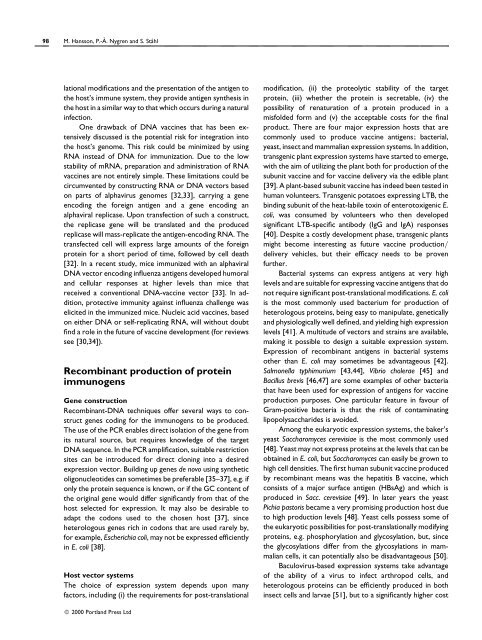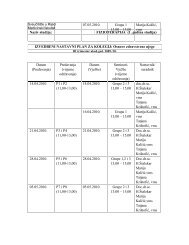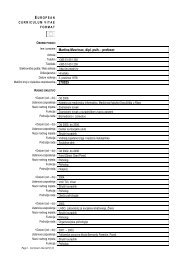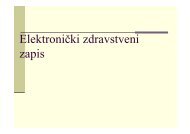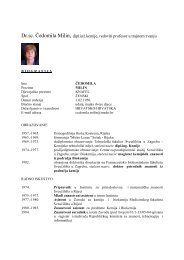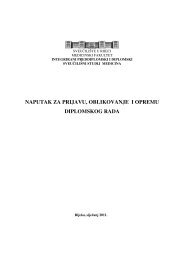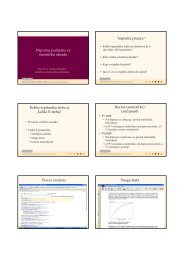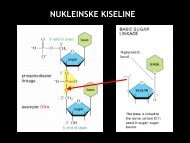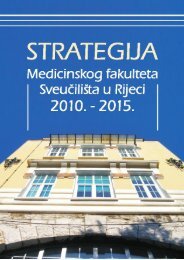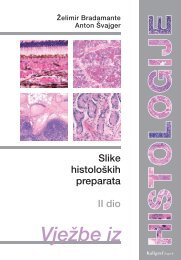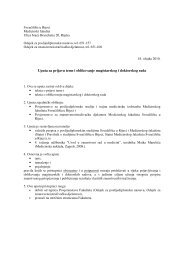REVIEW Design and production of recombinant subunit vaccines
REVIEW Design and production of recombinant subunit vaccines
REVIEW Design and production of recombinant subunit vaccines
Create successful ePaper yourself
Turn your PDF publications into a flip-book with our unique Google optimized e-Paper software.
98 M. Hansson, P.-A� . Nygren <strong>and</strong> S. Sta� hl<br />
lational modifications <strong>and</strong> the presentation <strong>of</strong> the antigen to<br />
the host’s immune system, they provide antigen synthesis in<br />
the host in a similar way to that which occurs during a natural<br />
infection.<br />
One drawback <strong>of</strong> DNA <strong>vaccines</strong> that has been extensively<br />
discussed is the potential risk for integration into<br />
the host’s genome. This risk could be minimized by using<br />
RNA instead <strong>of</strong> DNA for immunization. Due to the low<br />
stability <strong>of</strong> mRNA, preparation <strong>and</strong> administration <strong>of</strong> RNA<br />
<strong>vaccines</strong> are not entirely simple. These limitations could be<br />
circumvented by constructing RNA or DNA vectors based<br />
on parts <strong>of</strong> alphavirus genomes [32,33], carrying a gene<br />
encoding the foreign antigen <strong>and</strong> a gene encoding an<br />
alphaviral replicase. Upon transfection <strong>of</strong> such a construct,<br />
the replicase gene will be translated <strong>and</strong> the produced<br />
replicase will mass-replicate the antigen-encoding RNA. The<br />
transfected cell will express large amounts <strong>of</strong> the foreign<br />
protein for a short period <strong>of</strong> time, followed by cell death<br />
[32]. In a recent study, mice immunized with an alphaviral<br />
DNA vector encoding influenza antigens developed humoral<br />
<strong>and</strong> cellular responses at higher levels than mice that<br />
received a conventional DNA-vaccine vector [33]. In addition,<br />
protective immunity against influenza challenge was<br />
elicited in the immunized mice. Nucleic acid <strong>vaccines</strong>, based<br />
on either DNA or self-replicating RNA, will without doubt<br />
find a role in the future <strong>of</strong> vaccine development (for reviews<br />
see [30,34]).<br />
Recombinant <strong>production</strong> <strong>of</strong> protein<br />
immunogens<br />
Gene construction<br />
Recombinant-DNA techniques <strong>of</strong>fer several ways to construct<br />
genes coding for the immunogens to be produced.<br />
The use <strong>of</strong> the PCR enables direct isolation <strong>of</strong> the gene from<br />
its natural source, but requires knowledge <strong>of</strong> the target<br />
DNA sequence. In the PCR amplification, suitable restriction<br />
sites can be introduced for direct cloning into a desired<br />
expression vector. Building up genes de novo using synthetic<br />
oligonucleotides can sometimes be preferable [35–37], e.g. if<br />
only the protein sequence is known, or if the GC content <strong>of</strong><br />
the original gene would differ significantly from that <strong>of</strong> the<br />
host selected for expression. It may also be desirable to<br />
adapt the codons used to the chosen host [37], since<br />
heterologous genes rich in codons that are used rarely by,<br />
for example, Escherichia coli, may not be expressed efficiently<br />
in E. coli [38].<br />
Host vector systems<br />
The choice <strong>of</strong> expression system depends upon many<br />
factors, including (i) the requirements for post-translational<br />
� 2000 Portl<strong>and</strong> Press Ltd<br />
modification, (ii) the proteolytic stability <strong>of</strong> the target<br />
protein, (iii) whether the protein is secretable, (iv) the<br />
possibility <strong>of</strong> renaturation <strong>of</strong> a protein produced in a<br />
misfolded form <strong>and</strong> (v) the acceptable costs for the final<br />
product. There are four major expression hosts that are<br />
commonly used to produce vaccine antigens; bacterial,<br />
yeast, insect <strong>and</strong> mammalian expression systems. In addition,<br />
transgenic plant expression systems have started to emerge,<br />
with the aim <strong>of</strong> utilizing the plant both for <strong>production</strong> <strong>of</strong> the<br />
<strong>subunit</strong> vaccine <strong>and</strong> for vaccine delivery via the edible plant<br />
[39]. A plant-based <strong>subunit</strong> vaccine has indeed been tested in<br />
human volunteers. Transgenic potatoes expressing LTB, the<br />
binding <strong>subunit</strong> <strong>of</strong> the heat-labile toxin <strong>of</strong> enterotoxigenic E.<br />
coli, was consumed by volunteers who then developed<br />
significant LTB-specific antibody (IgG <strong>and</strong> IgA) responses<br />
[40]. Despite a costly development phase, transgenic plants<br />
might become interesting as future vaccine <strong>production</strong>�<br />
delivery vehicles, but their efficacy needs to be proven<br />
further.<br />
Bacterial systems can express antigens at very high<br />
levels <strong>and</strong> are suitable for expressing vaccine antigens that do<br />
not require significant post-translational modifications. E. coli<br />
is the most commonly used bacterium for <strong>production</strong> <strong>of</strong><br />
heterologous proteins, being easy to manipulate, genetically<br />
<strong>and</strong> physiologically well defined, <strong>and</strong> yielding high expression<br />
levels [41]. A multitude <strong>of</strong> vectors <strong>and</strong> strains are available,<br />
making it possible to design a suitable expression system.<br />
Expression <strong>of</strong> <strong>recombinant</strong> antigens in bacterial systems<br />
other than E. coli may sometimes be advantageous [42].<br />
Salmonella typhimurium [43,44], Vibrio cholerae [45] <strong>and</strong><br />
Bacillus brevis [46,47] are some examples <strong>of</strong> other bacteria<br />
that have been used for expression <strong>of</strong> antigens for vaccine<br />
<strong>production</strong> purposes. One particular feature in favour <strong>of</strong><br />
Gram-positive bacteria is that the risk <strong>of</strong> contaminating<br />
lipopolysaccharides is avoided.<br />
Among the eukaryotic expression systems, the baker’s<br />
yeast Saccharomyces cerevisiae is the most commonly used<br />
[48]. Yeast may not express proteins at the levels that can be<br />
obtained in E. coli, but Saccharomyces can easily be grown to<br />
high cell densities. The first human <strong>subunit</strong> vaccine produced<br />
by <strong>recombinant</strong> means was the hepatitis B vaccine, which<br />
consists <strong>of</strong> a major surface antigen (HBsAg) <strong>and</strong> which is<br />
produced in Sacc. cerevisiae [49]. In later years the yeast<br />
Pichia pastoris became a very promising <strong>production</strong> host due<br />
to high <strong>production</strong> levels [48]. Yeast cells possess some <strong>of</strong><br />
the eukaryotic possibilities for post-translationally modifying<br />
proteins, e.g. phosphorylation <strong>and</strong> glycosylation, but, since<br />
the glycosylations differ from the glycosylations in mammalian<br />
cells, it can potentially also be disadvantageous [50].<br />
Baculovirus-based expression systems take advantage<br />
<strong>of</strong> the ability <strong>of</strong> a virus to infect arthropod cells, <strong>and</strong><br />
heterologous proteins can be efficiently produced in both<br />
insect cells <strong>and</strong> larvae [51], but to a significantly higher cost


